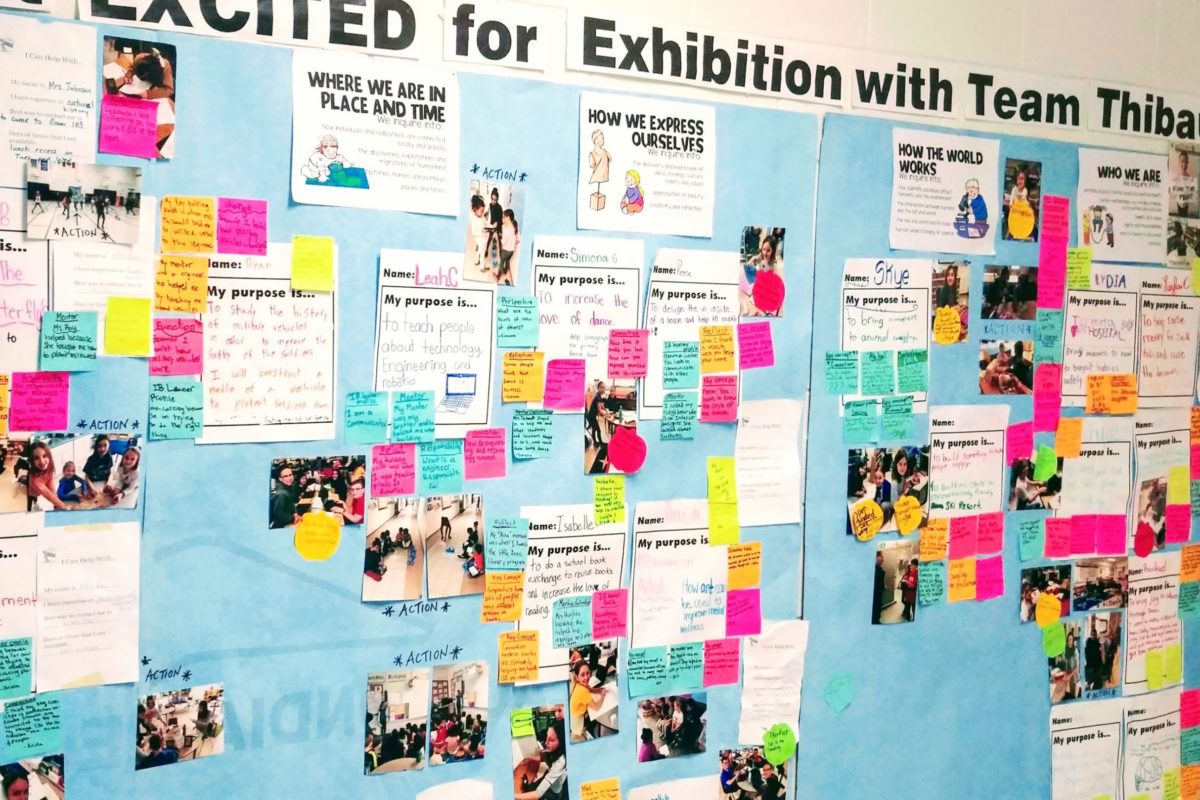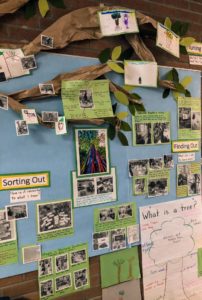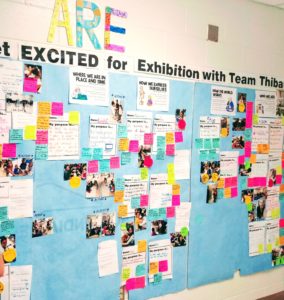Documenting inquiry is hard. The process takes skill and commitment. This article describes how a group of educators were introduced to the emerging curriculum framework to enhance their understanding of guiding and documenting the inquiry process. Through an initiative called the Living Walls project, teachers witnessed the power of collaboration as a tool for inquiry learning.

By Nicola Hughes
“These kinds of learning interactions where students own the inquiry align with the agentic learning goals for strengthening the learner in the enhanced PYP. “
The educators at St. James Catholic Global Learning Centre were engaging in self-study for the 5-year review and looking for ways to strengthen the teaching team’s implementation of inquiry-based teaching and learning. Our teachers are a diverse group of educators; some are more ahead in inquiry-based learning, while others are settling into the approach. The work of the more experienced teachers serves as inspiration for our staff. Teachers often stop in the hallways to comment on the beautiful documentation of inquiry practiced by our early year’s team. Their approach is influenced by the Reggio Emilia schools. They document the curriculum as it emerges based on student’s interests using the Kath Murdoch inquiry cycle. This method of recording the inquiry cycle not only captures the learning that is happening but moves it forward in a way that leads to successful inquiries. Our teachers were excited about what they were seeing and recognized the value of the inquiry walls as a structure for making sense of the inquiry cycle. The pedagogical team noticed how the emergent curriculum approach provided a lot of flexibility for learners to collaborate, make choices, and co-construct the learning. These kinds of learning interactions where students own the inquiry align with the agentic learning goals for strengthening the learner in the enhanced PYP.
Our reflections led us to this question: What if we used the emerging curriculum model to document the inquiry cycle for all grades/learners in the PYP? To explore this question, we launched a year-long initiative to use the emerging curriculum approach to create inquiry walls for each of the six units of inquiry.
We decided to call our initiative the Living Walls Project, a concept originating from the ecological term. It describes plants that grow vertically in indoor spaces (also known as a green wall). We likened the process of documenting inquiry to the careful planning, monitoring, and rich network of systems required for plant growth. Just as a living wall requires cultivation (the irrigation cycle) to thrive and grow plants, the living ‘inquiry’ wall requires a set of principles and specific learning processes to guide the learners to acquire new ideas and knowledge.
“There were some beautiful examples of inquiry wall design that revealed how varied and diverse inquiry can be with different grade levels and learning groups.”
 To increase the group’s confidence in exploring this initiative, we had the early year’s team share their experience. They presented their routines and instructional strategies for documenting classroom inquiry, explaining what is essential at each phase of the cycle. There were some key takeaways for the team:
To increase the group’s confidence in exploring this initiative, we had the early year’s team share their experience. They presented their routines and instructional strategies for documenting classroom inquiry, explaining what is essential at each phase of the cycle. There were some key takeaways for the team:
- Set expectations for the learning by reviewing the central idea and related concepts
- Visit the wall often to build explanations with the students
- Use the key concepts to anchor the investigations and pose deeper questions
- Be flexible with the cycle (move in a non-linear fashion) and make connections between the phases
- Authentically respond to learners by observing and noticing throughout the inquiry
 They gave teachers a feel for the kinds of activities that will invite students into the learning at the “tuning in” stage. To begin an inquiry into the Central idea, “Trees are a life-sustaining resource’, the educators constructed a tree structure out of branches to pique student’s curiosity to learn more about trees. They showed the class an image of an Angel Oak, a 500-year old tree located in South Carolina for students to share what they see, think, and wonder. The group experimented on a mystery object, “Jack Pine pinecone,” and learned an unexpected fact that the cone only opens to release tree seeds when it is exposed to fire. They described how play gives students space to contemplate the concepts on their terms and allows educators time to observe closely and gather documentation for the inquiry wall. The pinecone experiment was followed up with free exploration of various seed species and time outdoors to investigate the trees and leaves. These opportunities revealed student’s new questions about the animals that visit trees in the schoolyard, providing a student-initiated connection to the line of inquiry, Which animals live in trees and how they use different parts of the tree. Prompted by these initial understandings, the teachers planned a nature walk to a local forest for students to find their own answers in the “finding out” phase of the inquiry cycle. They returned students thinking to the Central idea by posing questions; Why are tree roots important to forests? Why are tree leaves (leaf litter) important protection for plants and animals in the springtime? (Causation). Before moving on, all the evidence of learning (student questions, tree diagrams/drawings, group conversations) was recorded on the “Tuning In” section of the inquiry wall. The educators stressed the importance of dialogue and conversation for on-going reflection of the learning experience. As new learning is added, the students gather at the wall to review the learning and determine where to go next with the inquiry. The early year’s team painted a compelling picture of the kinds of learning processes that facilitate learning at each phase of the cycle.
They gave teachers a feel for the kinds of activities that will invite students into the learning at the “tuning in” stage. To begin an inquiry into the Central idea, “Trees are a life-sustaining resource’, the educators constructed a tree structure out of branches to pique student’s curiosity to learn more about trees. They showed the class an image of an Angel Oak, a 500-year old tree located in South Carolina for students to share what they see, think, and wonder. The group experimented on a mystery object, “Jack Pine pinecone,” and learned an unexpected fact that the cone only opens to release tree seeds when it is exposed to fire. They described how play gives students space to contemplate the concepts on their terms and allows educators time to observe closely and gather documentation for the inquiry wall. The pinecone experiment was followed up with free exploration of various seed species and time outdoors to investigate the trees and leaves. These opportunities revealed student’s new questions about the animals that visit trees in the schoolyard, providing a student-initiated connection to the line of inquiry, Which animals live in trees and how they use different parts of the tree. Prompted by these initial understandings, the teachers planned a nature walk to a local forest for students to find their own answers in the “finding out” phase of the inquiry cycle. They returned students thinking to the Central idea by posing questions; Why are tree roots important to forests? Why are tree leaves (leaf litter) important protection for plants and animals in the springtime? (Causation). Before moving on, all the evidence of learning (student questions, tree diagrams/drawings, group conversations) was recorded on the “Tuning In” section of the inquiry wall. The educators stressed the importance of dialogue and conversation for on-going reflection of the learning experience. As new learning is added, the students gather at the wall to review the learning and determine where to go next with the inquiry. The early year’s team painted a compelling picture of the kinds of learning processes that facilitate learning at each phase of the cycle.
 Teachers were fully invested in working through this initiative. There were some beautiful examples of inquiry wall design that revealed how varied and diverse inquiry can be with different grade levels and learning groups. The photographs and drawings of students and the recording of their reactions, comments, and ideas were powerful demonstrations of students’ voice, choice, and ownership. Teachers used the inquiry walls to advocate for inquiry learning and to create comfort and continuity with their students during the COVID-19 school closure. An inquiry wall was set up in one of the educator’s homes to organize and facilitate a unit of inquiry. As the class moved through each phase of the inquiry cycle, a photograph was shared on Google classroom to:
Teachers were fully invested in working through this initiative. There were some beautiful examples of inquiry wall design that revealed how varied and diverse inquiry can be with different grade levels and learning groups. The photographs and drawings of students and the recording of their reactions, comments, and ideas were powerful demonstrations of students’ voice, choice, and ownership. Teachers used the inquiry walls to advocate for inquiry learning and to create comfort and continuity with their students during the COVID-19 school closure. An inquiry wall was set up in one of the educator’s homes to organize and facilitate a unit of inquiry. As the class moved through each phase of the inquiry cycle, a photograph was shared on Google classroom to:
- enrich parent’s understanding of how inquiry works
- help guide the reflection at home
- keep the inquiry moving forward in a meaningful way
“The routine of visiting the wall provided opportunities for our students to think and reflect on the learning experience using the IB language.”
The Living Walls initiative maximized our opportunities for collaboration. Having the inquiry walls in our shared space allowed multiple teachers to join in and offer feedback and practical solutions for the inquiry – new teachers felt well supported. Our subject specialist teachers built in the routine of visiting the walls to identify how they can support new learning of the central idea through their subject area. These contributions and positive encouragement from the wider community enhanced the quality of the units of inquiry.
An exciting outcome of establishing this initiative has been stronger student engagement in the elements of the PYP. The routine of visiting the wall provided opportunities for our students to think and reflect on the learning experience using the IB language. The essential elements are visually displayed, referred to and reflected on throughout the inquiry. The students are more informed of these key components of the IB program.
 This professional learning experience is in the early stages, but it has increased teacher’s confidence in facilitating inquiry. Teachers shared sharper reflections of their inquiries during our weekly collaborative planning meetings. They are planning more responsively to the students by matching their needs and interests with the curriculum. One teacher described how rewarding it was to view her finished inquiry wall. Seeing all the components of the learning cycle helped her understand the bigger picture purpose of inquiry.
This professional learning experience is in the early stages, but it has increased teacher’s confidence in facilitating inquiry. Teachers shared sharper reflections of their inquiries during our weekly collaborative planning meetings. They are planning more responsively to the students by matching their needs and interests with the curriculum. One teacher described how rewarding it was to view her finished inquiry wall. Seeing all the components of the learning cycle helped her understand the bigger picture purpose of inquiry.
Just as plant walls contribute significant positive benefits to the environment, the living “inquiry” walls provided our teachers and students an opportunity to grow as thinkers and learners. The positive energy generated through a school-wide embrace of the Living Walls Project is something that we are looking forward to continuing as we move into this academic year.
References:
Benham-Lewin, A. (March 2006). One Teacher, 20 Preschoolers, and a Goldfish, Environmental Awareness, Emergent Curriculum, and Documentation. Beyond the Journal, Publication (1):1 -7. Washington, DC: National Association for the Education of Young Children
Murdoch, K. (2015) The Power of Inquiry. Melbourne, Victoria: Seastar Education
Ritchhart, R, Church, M, Morrison, K. (2011) Making Thinking Visible: How to Promote Engagement, Understanding, and Independence for All Learners San Francisco, CA: Jossey-Bass Publishing

Nicola Hughes is the PYP Coordinator at St. James Catholic Global Learning Centre in Ontario, Canada. She is especially interested in the role of the curriculum to help students develop thinking and creativity in all settings of learning. Nicola tweets videos and photographs of the Living Walls Project @St.JamesCGLClib

No comments yet.